ABOUT US
根のROOTSを探る
Exploring the Roots
日本語では物事の「根源」や「根本」、英語でも”ROOTS”という言葉が示すように、「根」は物事がそこから出発している、おおもとという意味を持ちます。すなわち、根を知ること、根の大きさを調節できるようになれば、植物の成長そのものを知ることができるといえます。
In Japanese, the words "根源" (kongen) and "根本" (konpon) signify the fundamental essence of things. Similarly, the English term "ROOTS" conveys the notion that everything stems from a foundation. In this context, "roots" represent the starting point, the very origin of things, from which other things have developed. To comprehend the roots, to gain insight into their depth, is to grasp the essence of a plant's growth itself.
植物にとって、根は個体全体を支える役割、土壌から水や養分を吸収するとても大切な機能を持っています。それだけではなく、一度根付くと動くことができない植物は、成長している周りの環境が生育に不利な条件に変化した時に、動物のようにその場所から逃げることはできません。
For plants, roots play a vital role in supporting the entire organism, as well as absorbing water and nutrients from the soil. However, a plant once rooted, cannot move, unlike animals who can escape adverse environmental conditions by relocating. Therefore, a plant must sense changes in the surrounding environment and regulate growth accordingly. Thus, roots also serve as crucial sensors, monitoring change in the growing environment.
その環境の変化を感じ取り、成長を調節する必要があるのです。その環境変化をモニターするセンサーとしても根は重要な役割を果たしています。
We are engaged in the challenge of unraveling the mechanisms that control root growth and its role as a sensor, employing molecular biology, imaging techniques, and machine learning. Our focus lies particularly on transcription factors governing gene expression and the intricate transcription networks they control. Our aspiration is to one day uncover the true "roots" of plant growth.
私たちはその根の成長の制御メカニズムやセンサーとしての役割を、分子生物学、イメージング、機械学習を用いて明らかにしようと挑戦をしています。特に遺伝子発現を司る転写因子やその制御下にある転写ネットワークに焦点を当てています。いつか植物の成長の「根源」を突き止めたいと思っています。

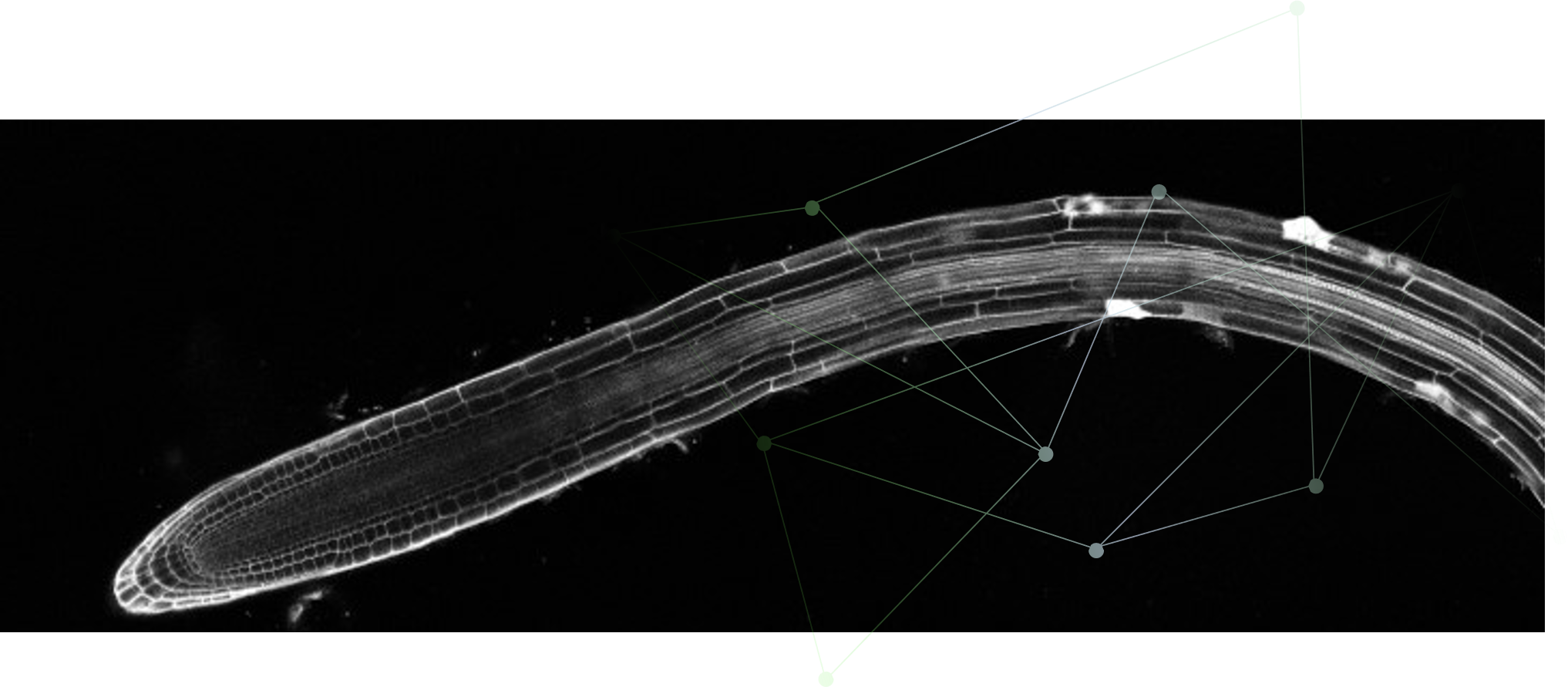
-
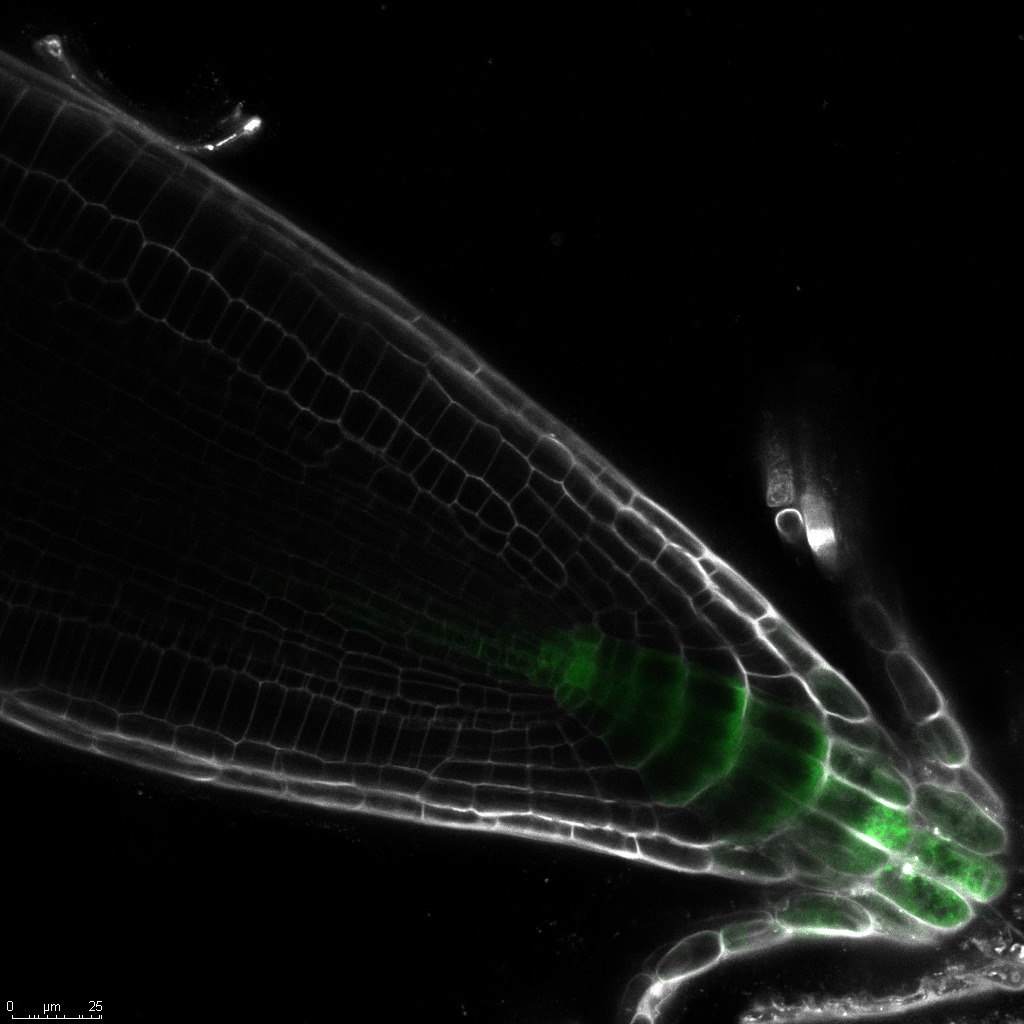

主根の成長制御機構
Regulation of Primary Root Growth
Keyword:活性酸素種(ROS)、転写因子
-


側根発達制御
Regulation of Lateral Root Development
Keyword:側根、極長鎖脂肪酸、概日時計、転写ネットワーク
-
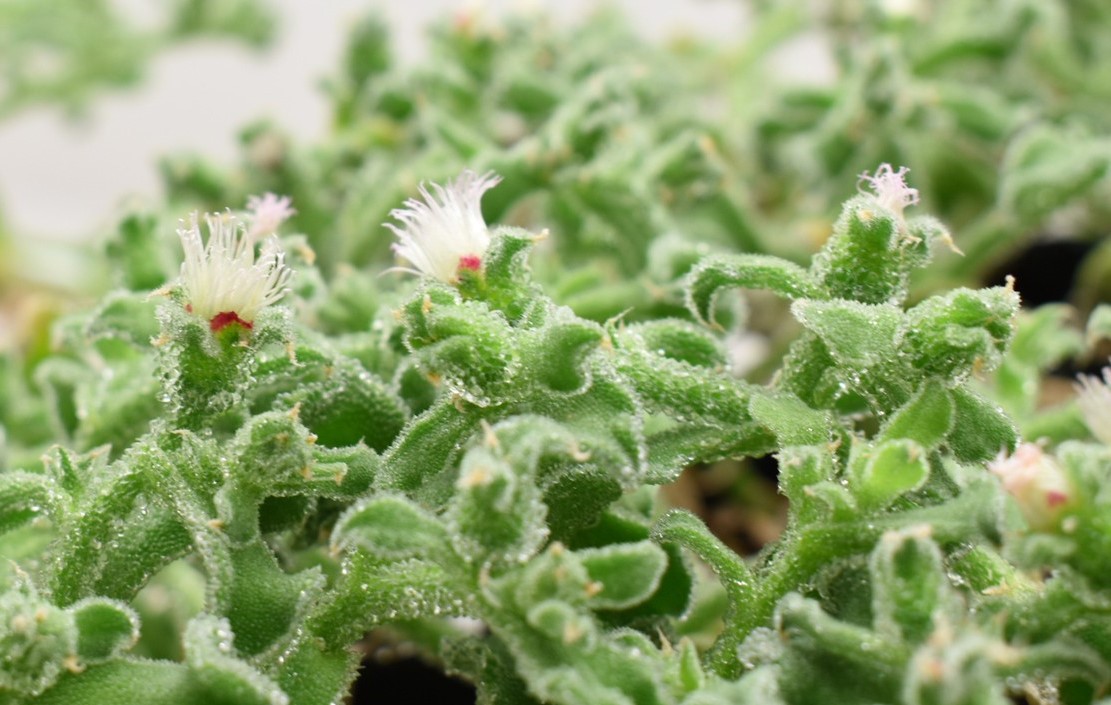

野生種から解き明かす植物耐塩性メカニズム
Unveiling Plant Salt Tolerance Mechanisms from Wild Species
Keyword:アイスプラント、塩屈性、ROS、オーキシン
-
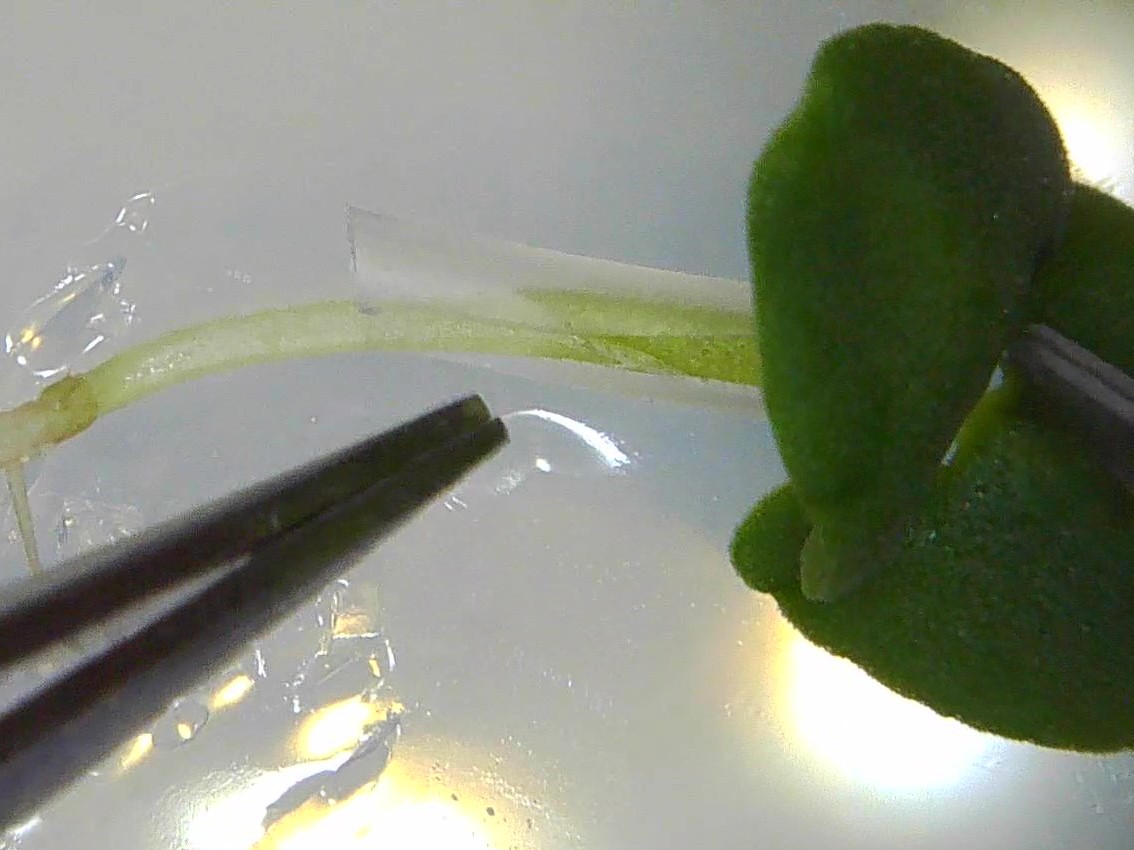

接木を用いた香気成分の改変への挑戦
Challenges in Modifying Aromatic Compounds Using Grafting
Keyword:香気成分、接木、物質移動、
-
主根の成長制御機構
Regulation of Primary Root Growth
主根の成長には、根端での細胞分裂から細胞伸長への正しい細胞機能転換が重要です。このバランスが崩れると、動物のガンのように、根も成長しなくなってしまいます。この細胞機能転換には、オーキシンなどの植物ホルモンによる制御系が多く証明されています。私たちは植物ホルモンに加えて、根端での活性酸素種(ROS)の恒常性が細胞機能転換に重要であり、これを制御する転写因子UP BEAT1(UPB1)を発見しました( Tsukagoshi et al., 2010, Cell)。
The proper transition of cellular functions from cell division at the root tip to cell elongation is crucial for primary root growth. If this balance is disrupted, much like in animal cancers, the root growth becomes impaired. This cellular functional transition is largely regulated by plant hormones such as auxin. In addition to plant hormones, we have discovered that the homeostasis of reactive oxygen species (ROS) at the root tip is essential for this process, and we have identified a key transcription factor UP BEAT1 (UPB1) that controls the homeostasis for normal root growth ( Tsukagoshi et al., 2010, Cell).
ROSはその化学エネルギーの高さから、細胞成長にとって不利だと考えられていましたが、根端では細胞周期の調節など積極的にROSを利用しています( Tsukagoshi, 2012, Plant Sci.)。
さらに私たちはROSに応答して遺伝子発現を制御する転写因子MYB30とANAC032も同定しています( Mabuchi et al., 2018, PNAS., Maki et al., 2019, Sci. Rep.)。 MYB30は興味深いことに植物病害応答時にも働き、成長と植物免疫の天秤のかなめになっていることもわかりました( Mabuchi et al., 2018, PNAS , Youtube10大発見)。 このようにROSによる新たな植物の根の成長制御機構というものを発見し、更なる研究を続けています。ROS, despite being considered detrimental for cell growth due to their high chemical energy, are actively utilized at the root tip for regulatory processes like the cell cycle ( Tsukagoshi, 2012, Plant Sci.). Furthermore, we have also identified the transcription factors MYB30 and ANAC032 that control gene expression in response to ROS ( Mabuchi et al., 2018, PNAS., Maki et al., 2019, Sci. Rep.). Remarkably, MYB30 is involved in plant immune responses and plays a pivotal role in balancing growth and plant immunity ( Mabuchi et al., 2018, PNAS , Youtube10大発見). Through these findings, we have uncovered a novel mechanism for controlling root growth in plants mediated by ROS and continue our research to delve deeper into this fascinating realm.
我々はROS恒常性とは別のUPB1下流の転写因子による主根成長メカニズムの解析も進めています。そこで、UPB1の標的遺伝子の一つである転写因子MYB50の機能解析を進めました。MYB50にGFPを融合させたタンパク質をMYB50のプロモーターでドライブさせた植物に、UPB1とCFPを融合させたタンパク質を過剰発現させた多色蛍光タイムラプス解析法を開発し研究を進めました。その結果、UPB1-CFPの発現上昇とともにMYB50-GFPが消えていく、すなわちUPB1-MYB50の転写ネットワークを根の細胞で可視化することができました。さらにMYB50の過剰発現株を用いたRNA-seqとChIP-seq解析を行い、MYB50下流の遺伝子群を網羅的に同定しました。その中でも細胞壁構成に関わるPMEI8の解析を進め、PMEI8がMYB50下流で根の細胞伸長を制御することを発見しました( Mase et al., 2023, PLoS One )。
In addition to our work on ROS homeostasis, we are investigating alternative pathways downstream of the transcription factor UPB1 that regulate primary root growth. As part of this study, we focused on MYB50, a transcription factor identified as a target gene of UPB1. To elucidate the dynamics of the UPB1-MYB50 transcriptional network, we developed a multicolor fluorescent time-lapse imaging system. This system enabled simultaneous visualization of MYB50-GFP expressed under its native promoter and UPB1-CFP driven by a constitutive promoter. Using this platform, we observed that MYB50-GFP fluorescence gradually diminished in response to increased UPB1-CFP expression, providing direct evidence of the UPB1-MYB50 regulatory network in the living cells. To uncover downstream targets of MYB50, we performed RNA-seq and ChIP-seq analyses using MYB50-overexpressing lines. Among the identified target genes, we characterized PMEI8, which encodes a cell wall-related protein, and demonstrated its role in regulating cell elongation in the root downstream of MYB50 Mase et al., 2023, PLoS One.
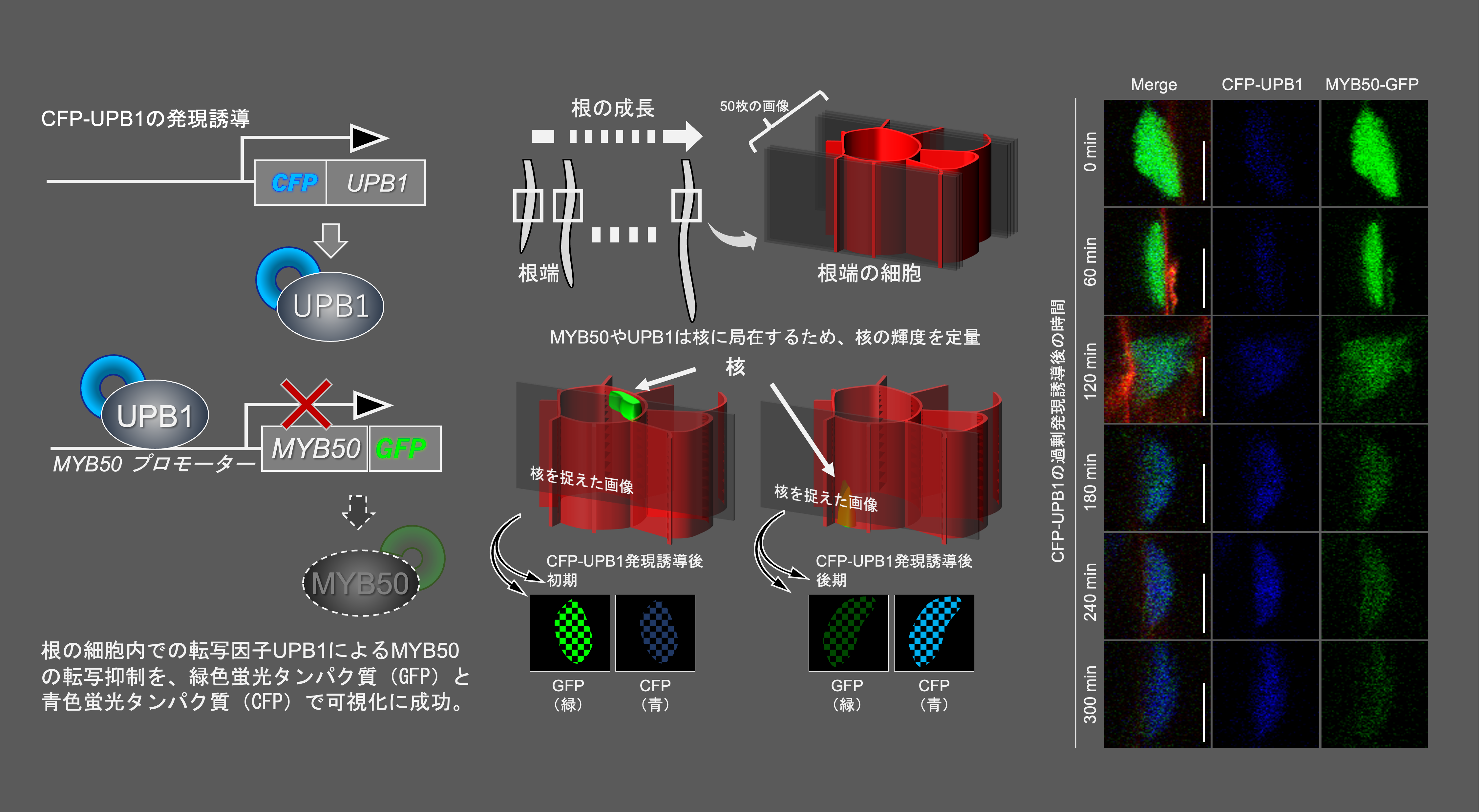
MYB50はPMEI8 だけでなく植物ホルモンABAに応答するいくつかの遺伝子発現も制御していました。そこで、MYB50とABAシグナルの関係も解析しました。興味深いことにABAはMYB50 の遺伝子発現のみならず、タンパク質安定性も制御していることがわかりました。一方で、ABAシグナル下で根の成長制御に働く重要な転写因子であるABI5はMYB50と異なる制御を受けていることもわかりました。我々の結果はABAがMYB50の転写と転写後制御の二重の制御系を司ることで、ABAに応答した根の成長のファインチューニングを行っていることを示しています( Mase et al., 2024, Biosci. Biotechnol. Biochem. )。
Beyond PMEI8, MYB50 was also found to regulate the expression of several genes involved in abscisic acid (ABA) signaling. We therefore investigated the relationship between MYB50 and ABA responses. Interestingly, ABA not only suppresses MYB50 gene expression but also reduces its protein stability. In contrast, ABI5, a key transcription factor mediating ABA-dependent root growth responses, exhibited a distinct regulatory pattern. Our findings suggest that ABA fine-tunes root growth by coordinately regulating MYB50 at both the transcriptional and post-transcriptional levels( Mase et al., 2024, Biosci. Biotechnol. Biochem. ).
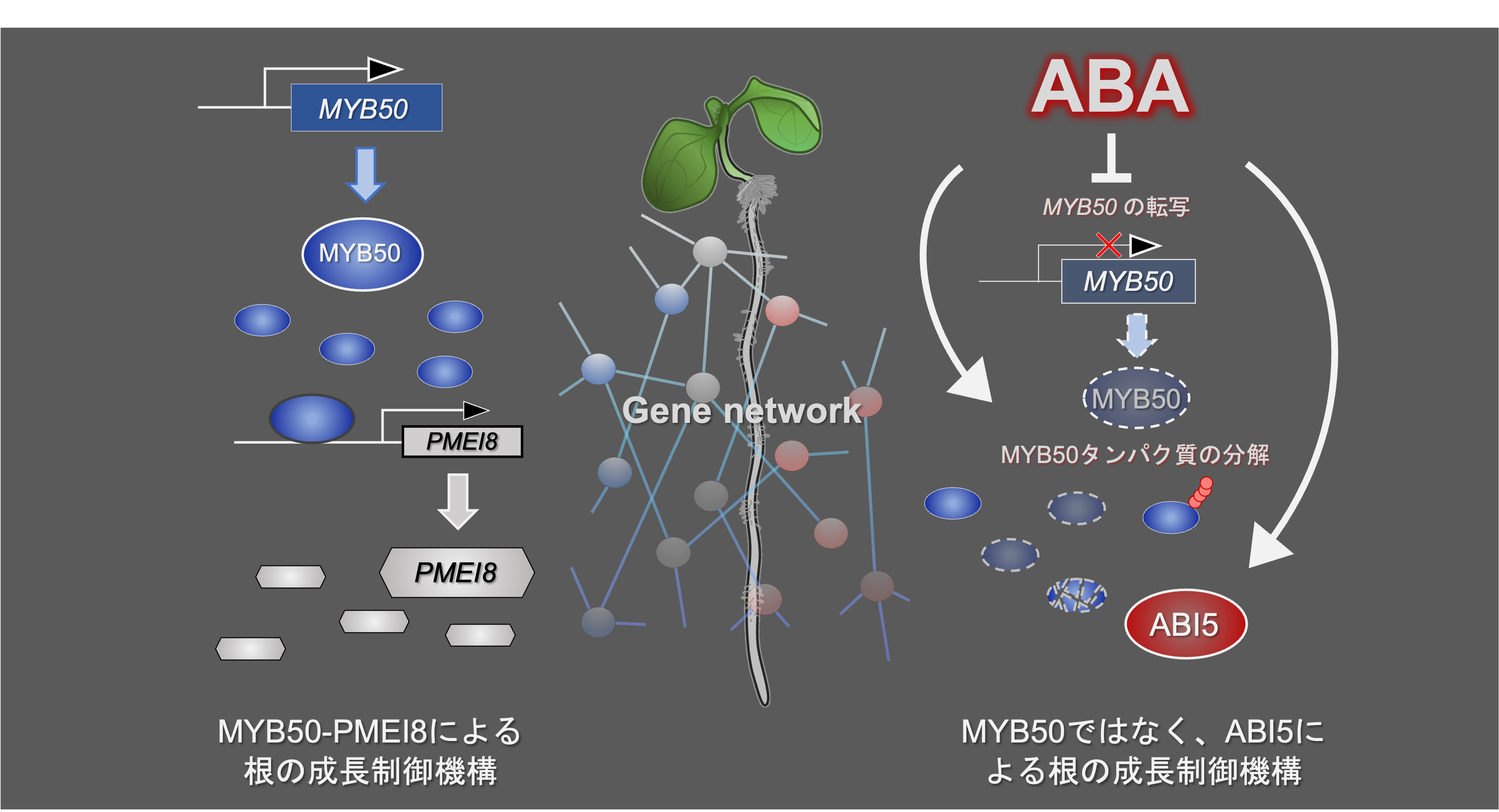
-
-
側根発達制御
Regulation of Lateral Root Development
植物の根の成長には主根の成長だけでなく、側根を発達させ分岐することで大きな根系を作ることも大切です。側根の発達にもオーキシンの制御系が重要で、特に周期的な側根発達にはRoot Clockと言われるメカニズムが大切であることが証明されています。私たちは主根の成長制御機構の研究過程で、UPB1の下流で働く転写因子やROSの下流で働く分子が側根の発達に関わることを発見しました。
UPB1下流の転写因子は側根そのものの発達というよりも、側根に覆い被さっている主根側からの側根出現に鍵となることがわかってきました。また、ROS下流では極長鎖脂肪酸(VLCFA)が働き、特定の転写ネットワークを起動させることで側根発達に関わることもわかってきました。
私たちはMYB93が転写レベルでVLCFAに応答し、その下流で細胞壁構築に関わる遺伝子の発現を調節することで側根の出現を制御していることを発見しました ( Uemura et al., 2023, Plant J.)。 MYB93の解析では、機械学習を取り入れて側根発達ステージの検出系も構築しています。さらにRoot Clockとは独立して、植物概日リズムも側根発達に関わることが報告されており、これらの因子群がどのような転写ネットワークを制御しながら側根発達に関わるかの研究を進めています。In the growth of plant roots, it is not only the elongation of the primary root, but also the development and branching of lateral roots to establish an expansive root system architecture. The control system of auxin is pivotal for lateral root development, especially in the context of periodic lateral root emergence, where a mechanism known as the 'Root Clock' has been proven to be crucial. During our investigation into the regulatory mechanisms of primary root growth, we have uncovered factors downstream of UPB1 and molecules downstream of ROS that play roles in lateral root development.
The transcription factors downstream of UPB1 are not only linked to lateral root development itself, but also play a key role in the lateral root overlay cells. Furthermore, in the ROS pathway, very-long-chain fatty acids (VLCFAs) have been identified as contributing to lateral root development by activating specific transcription networks. We identified that MYB93 responds to VLCFA at the transcription level and controls lateral root emergence by downstream regulation of expression of genes involved in cell wall modification ( Uemura et al., 2023, Plant J.). During MYB93 study, we develop the automatic detection system for lateral root developmental stages by incorporating machine learning. Additionally, apart from the Root Clock, the plant's circadian rhythm has also been implicated in lateral root development. Our ongoing research delves into understanding how these factors regulate transcription networks and contribute to lateral root development. -
野生種から解き明かす植物耐塩性メカニズム
Unveiling Plant Salt Tolerance Mechanisms from Wild Species
植物の中には海水のような高い塩濃度条件でも生育できる野生種が存在します。塩害は農業生産上、世界レベルで深刻な問題になっています。そこで、耐塩性植物の塩耐性メカニズムを調べ、そこから塩害に強い植物生産につながる研究を進めています。耐塩性植物の中でも実験室レベルで扱いやすい、アイスプラントの根を用いています。アイスプラントはモデル植物ではなく、そのゲノム配列が未決定です。そこで私たちはまず、高速シークエンサーを用いてアイスプラントmRNAデータベースを構築しました( Tsukagoshi et al., 2015. PLoS One.)。 このデータベースから選抜したアイスプラントのナトリウムトランスポーターを過剰発現させたシロイヌナズナは耐塩性を持ちました( Nishijima et al., 2017, BBB.)。 この結果は、野生種が持つ能力を生かした新しい塩耐性遺伝子源の獲得ができることを示しています。また、アイスプラントの根は高い塩濃度下では屈曲しながら成長していく塩屈性を持つことがイメージングからわかり、その屈性にはアイスプラントのオーキシン応答性遺伝子やROSが関わることを発見しました( Ohtsuka et al., 2021, Biol Open.)。 このようにアイスプラントの根の成長様式を研究することで、非耐塩性植物ではわからなかった新たな現象や遺伝子資源を見つけることができ、更なる研究を進めています。
In the world, there exist wild plant species capable of thriving even under conditions of high salt concentration akin to seawater. Salt stress poses a significant challenge to agricultural productivity on a global scale. Consequently, we are investigating the salt tolerance mechanisms of salt-resistant plants to lead to robust plant production under saline conditions. Among salt-resistant plants, we have focused on the root of the ice plant (Mesembryanthemum crystallinum) due to its ease of handling in laboratory settings. Unlike a model organism, the ice plant lacks a sequenced genome. To address this, we initially constructed an ice plant root mRNA database using high-throughput sequencing ( Tsukagoshi et al., 2015. PLoS One.). Selecting sodium transporters from this database, we found that overexpressing these in Arabidopsis thaliana conferred salt resistance ( Nishijima et al., 2017, BBB.). This outcome highlights the potential for acquiring novel salt-tolerant genetic resources from the abilities possessed by wild species. Furthermore, through imaging techniques, we observed that ice plant roots exhibit salt-dependent tropism (halotropism), bending as they grow in high salt concentrations. This halotropism was found to involve ice plant's auxin-responsive genes and ROS ( Ohtsuka et al., 2021, Biol Open.). Studying the growth patterns of ice plant roots has enabled us to uncover previously unknown phenomena and genetic resources that were not evident in non-salt-resistant plants. We continue to advance our research in this direction.
-
バジルの接木から明らかになったオイゲノール輸送と植物免疫強化
Research on Eugenol Transport and Immunity Priming
植物は根と地上部でコミュニケーションをとっている事が知られています。コミュニケーションのための化合物は様々存在しますが、植物の生育環境をモニターして化合物は根から地上部、その逆の地上部から根へ移動しています。そこで、私たちは移動する化合物を成長制御だけでなく、物質生産のために利用できないかと考え、接木を用いて色々な植物の地上部と根での香気成分変化を調べています。この研究が進むことで、遺伝子組換えを利用しない新たな化合物の合成が可能になると期待しています。
It is known that plants communicate between their roots and shoots. Various compounds are involved in this communication, with these compounds monitoring the plant's growth environment and moving from roots to shoots, and vice versa. With this in mind, we are exploring the changes in aromatic compounds between the shoot and root parts of various plants using grafting techniques. Beyond growth regulation, we are investigating whether these mobile compounds could be harnessed for metabolite production. As this research progresses, we anticipate the potential to synthesize new compounds without the need for transgenic plants.
バジルのオイゲノール輸送能
Research on Eugenol Transport and Immunity Priming
シソ科バジルは、揮発性有機化合物(VOC)の一つであるオイゲノールを豊富に含む植物種です。従来、バジルではオイゲノールが地上部から根へ輸送されることが知られていましたが、遺伝子発現レベルの解析にとどまっていました( Singh et al., 2020, Phytochem. )。私たちは、2つの異なる植物をつなぐ「接ぎ木」を用いることで、バジルの地上部から根へのオイゲノール輸送を直接明らかにしました。バジルは驚くべきことに、オイゲノールを生合成しない異種植物(本研究ではタバコとタイムを使用)の根にもオイゲノールを輸送する能力がありました。さらに、バジルの根のタンパク質抽出液を用いて、バジルの根でのオイゲノール生合成活性を検出しました ( Hirose et al., 2024, Plant Biotechnol. )。
Basil, a member of the Lamiaceae family, is a plant species rich in eugenol, a volatile organic compound (VOC). It has been suggested that eugenol would be transported from shoot to root in basil, however, evidences have been limited to gene expression analyses ( Singh et al., 2020, Phytochem. ). Using grafting, a method of joining two different plants, we revealed the transport of eugenol within basil from shoots to roots. Remarkably, the activity of eugenol transport is also observed in heterologous plants that do not synthesize eugenol (we used tabaco and thyme in this analysis). Additionally, we revealed that basil roots exhibit their own biosynthetic activity for eugenol production by using in vitro enzyme assay ( Hirose et al., 2024, Plant Biotechnol. ).
オイゲノールによる免疫プライミング
Immune Priming by Eugenol
オイゲノールの生理活性として植物免疫力をあらかじめ高める効果(免疫プライミング)があります。オイゲノールを処理することで、ナス科トマトの病原性ウイルスに対する免疫プライミング応答が起こります( Tsai et al., 2019, Front Plant Sci. )。私たちは、オイゲノールを豊富に含むバジル抽出液やオイゲノールそのものが、アブラナ科シロイヌナズナで、病原性原核細菌に対する免疫プライミングを高めることを遺伝子発現レベルから明らかにしました。また、この免疫プライミングは免疫応答の鍵因子NPR1依存的ではあるが、サリチル酸への依存度が低いことも遺伝学的解析から明らかにしました( Hirose et al., 2024, Biosci. Biotechnol. Biochem. 2025年1月号表紙 )。
Eugenol, a biologically active compound, has been shown to enhance plant immunity through a process known as immune priming. In tomato, a member of the Solanaceae family, eugenol treatment triggers immune priming responses against pathogenic viruses ( Tsai et al., 2019, Front Plant Sci. ). Our research has demonstrated that both basil extract—rich in eugenol—and eugenol itself enhance immune priming in the Brassicaceae model plant Arabidopsis thaliana against pathogenic bacteria. Gene expression and genetic analysis showed that the eugenol-induced immune priming is dependent on NPR1, a central regulator of plant immunity, but is only weakly dependent on salicylic acid ( Hirose et al., 2024, Biosci. Biotechnol. Biochem. Featured on the cover of the January 2025 issue ).
私たちの研究成果を基盤として、バジルが持つオイゲノールなどの化合物輸送メカニズムやオイゲノールの免疫プライミング効果をさらに詳細に研究し、接ぎ木を活用した持続可能な農業技術の開発を進めています。この技術は、遺伝子組み換えに頼らず、化学農薬の使用量削減や環境負荷の軽減に寄与し、持続可能な農業の実現に大きく貢献する可能性を秘めています。
Building on our finding, we are conducting further in-depth investigations into the mechanisms of eugenol transport in basil and its immune-priming effects. Our ultimate goal is to develop sustainable agricultural technologies through the application of grafting techniques. This strategy holds great promise for reducing reliance on chemical pesticides, minimizing environmental impact, and promoting sustainable farming practices without the use of genetically modified organisms.

